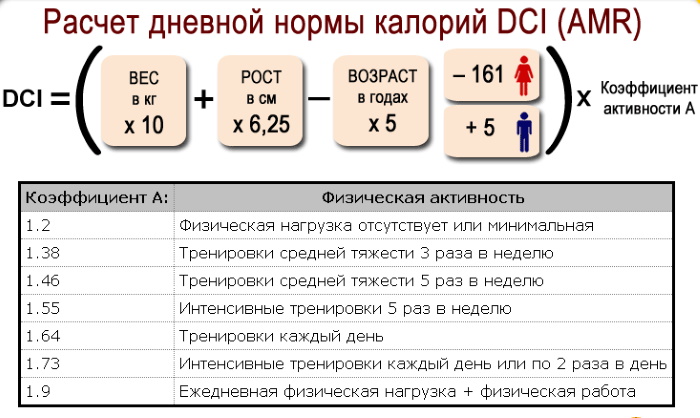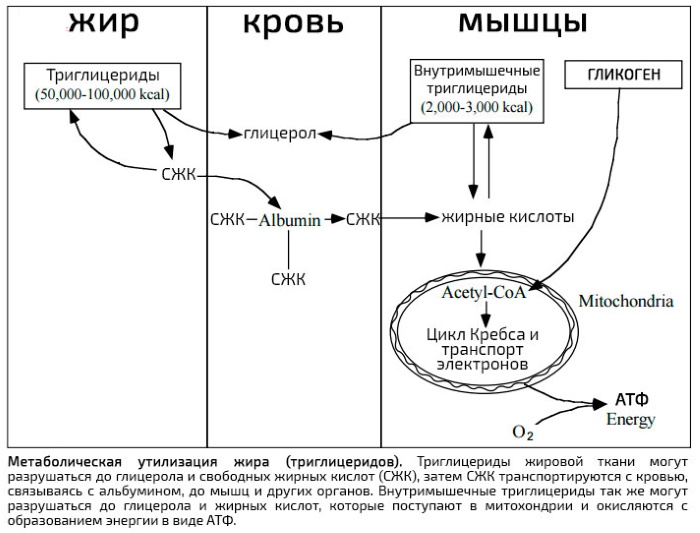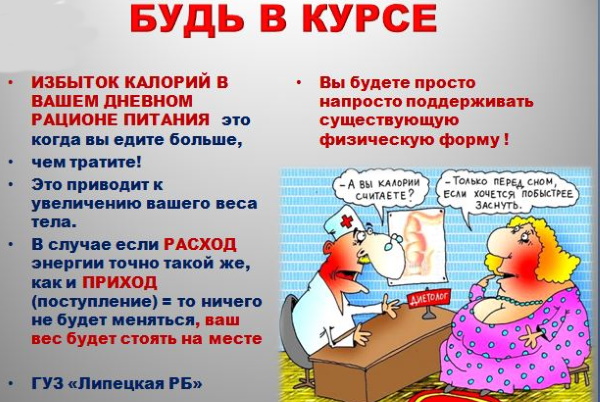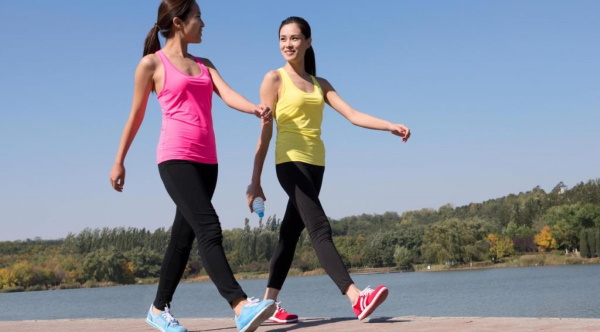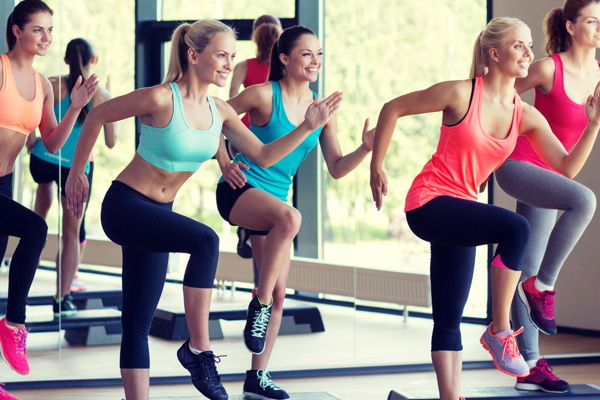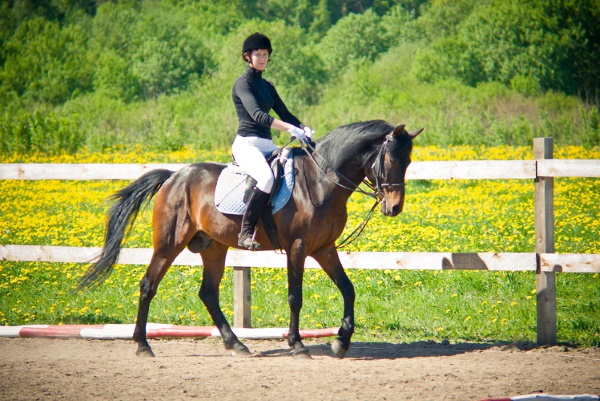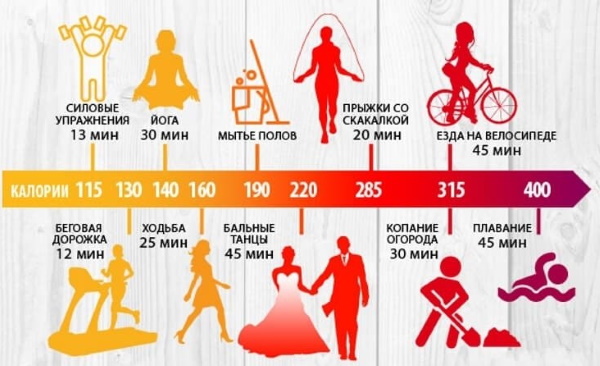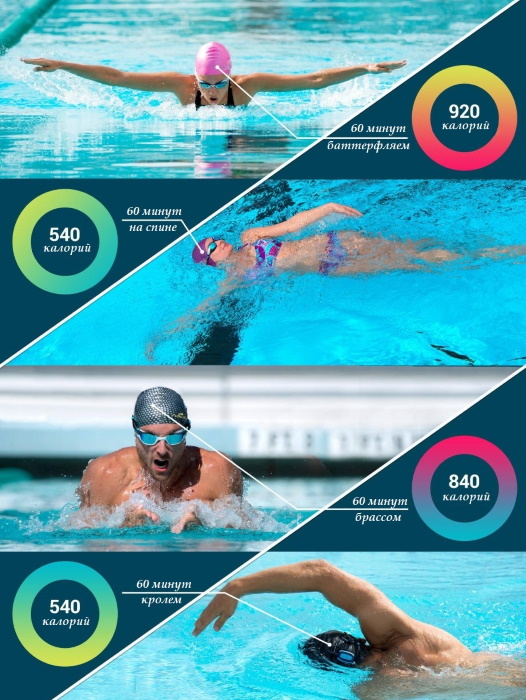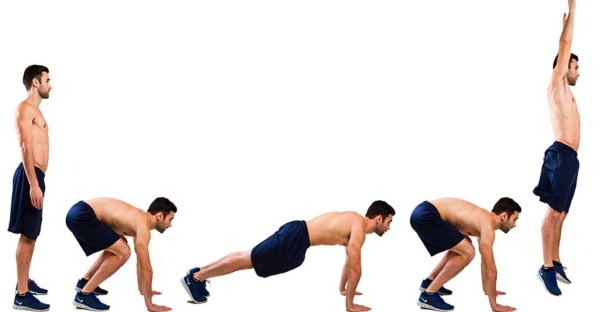Burning calories is the expenditure of energy to ensure the normal process of human life. The very concept of "calorie" means a conventional unit of heat or energy that is required to heat 1 g of water to a temperature of 1aboutFROM.
Energy is generated during the processing of "fuel" - food. Allocation or consumption of calories increases with exercise. A number of tables later in the article indicate the calorie consumption for various activities.
Daily human calorie requirement
To determine the daily calorie requirement of a person, formulas are used that take into account the individual parameters of a person. The most common and simple ones are the Harris-Benedict calculations without taking into account physical activity and muscle mass.
Men: 88.362 + (13.397 x BC) + (4.799 x PC) - (5.677 x OT)
Women: 447.593 + (9.247 x BC) + (9.098 x RS) - (4.330 x OT)
Legend:
- Sun - current weight, kg.
- RS - height, see
- OT - age, years.
Example: a 53-year-old man, weight 95 kg, height 175 cm.88.362 + (13.397 x 95) + (4.799 x 175) - (5.677 x 53) = 1900 kcal.
Basically, this formula is used to determine the metabolic rate (BMR). This is the amount of energy that is needed for the work of important organs such as the heart, lungs, central nervous system, endocrine system, kidneys, liver, intestines, genitals, muscles and others. These energy inputs are called unregulated.
For a more accurate determination of the daily calorie intake, physical activity and activity coefficient should be taken into account.
Calorie burn during physical activity (the table of types of physical activity taking into account the activity coefficient is presented below) increases depending on the intensity of the load.
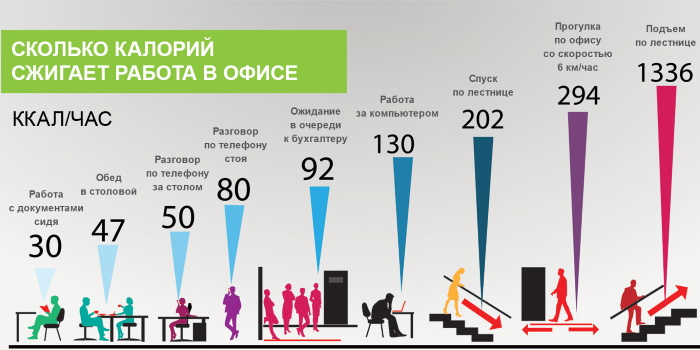
Levels of daily activity:
| Types of physical activity | Calculation of the level of daily activity (taking into account the coefficient) |
| Sedentary lifestyle, light housework | BMR x 1.2 |
| Low physical activity: jogging, roller skating, volleyball, rowing and others. The duration of the exercises is at least 20 minutes 2-3 rubles / week | BMR x 1.3 - 1.38 |
| Moderate Activity: All of the above activities. Intense load for 30-60 minutes 3-4 r / week | BMR x 1.5 - 1.55 |
| Intense load: all kinds of sports for 60 or more minutes 5-7 r / week. Work associated with hard physical labor (builder, bricklayer, carpenter, farmer and others) | BMR x 1.7 |
| Very intense physical activity: long-term training of professional athletes throughout the day according to special programs that require a lot of energy; hard physical labor (miner or assembly line worker) | BMR x 1.9 |
Dependence of energy loss on body structure
The more a person's body weight, the more calories he spends during the day, even at rest.Maintaining muscle mass requires almost twice as many calories as fat. According to research, 5 kg of muscle burns 56 kcal per day, 5 kg of fat consumes only 22 kcal during this period.
Many people who are overweight, namely high in body fat, tend to "blame" the slow metabolism for everything.
This is partly true. But metabolic rate is rarely the root cause of excess weight. Although it is associated with the main energy consumption of the body, the main indicator is a value that shows how many calories a person consumes, and how much he spends through physical activity.

 Don't miss the most popular column article: Laser hair removal on the face and body - how it is carried out, effectiveness, before and after photos, contraindications.
Don't miss the most popular column article: Laser hair removal on the face and body - how it is carried out, effectiveness, before and after photos, contraindications.General rules for burning calories
If more calories are supplied from food than energy is expended as a result of physical activity, then the body triggers the mechanism of storing fat for a "rainy day". This process was formed due to evolution and is natural for the body. Fat burning is the process of releasing fat from storage and breakdown fat cells, resulting in energy.
Fat cells mainly contain triglycerides, which are converted to fatty acids and released into the bloodstream. They are actually the elements for the formation of energy.
Forces fat to leave the fat cell hormone-sensitive lipase. This enzyme is involved in fat metabolism. Adrenaline, which is produced by the adrenal glands and released into the bloodstream during exercise, activates lipase. This is how the fat burning process begins.
Why count calories
If weight and body constitution do not change over a long period of time, then a balance has been achieved between the daily calorie requirement and calorie expenditure. As you know, a surplus of calories is important for gaining body weight, that is, the daily calorie intake of foods should exceed the daily requirement.
If the main goal is to part with extra pounds, then a calorie deficit is necessary. In short, counting calories consumed is indispensable.
In practice, one should:
- Calculate your daily calorie requirement based on exercise (detailed above).
- Calculate your daily caloric intake from food and drink.
To burn calories effectively, it is necessary to subtract about 200-500 kcal from the daily requirement or increase physical activity, creating a deficit solely due to exercise.
Burning calories is a complex, ongoing process. For additional energy consumption, the volume and intensity of physical activity increases. This will be discussed later. To find out the number of calories entering the body, it is necessary to record data and make calculations daily. A kitchen scale, calculator and calorie tables should be at hand.
Calorie consumption for various physical activities. Table
Calorie burn during exercise (a table of calorie consumption according to Harvard Medical School is presented later in the article) depends on a number of factors: type of physical activity, exercise intensity, body structure of a person, his age, and others.
The faster the pace of the exercise, the higher the calorie consumption:
| Calorie consumption for 1 hour, kcal | |||
| Type of physical activity | Human weight, kg | ||
| 57 | 70 | 84 | |
| Weightlifting | 180 | 224 | 266 |
| Aqua aerobics | 240 | 298 | 356 |
| Hatha yoga | 240 | 298 | 356 |
| Physical exercise at a moderate pace | 270 | 334 | 400 |
| Horseback riding | 300 | 372 | 444 |
| Aerobics at a low pace | 330 | 410 | 488 |
| Step aerobics | 420 | 520 | 622 |
| Aerobics at a high pace | 420 | 520 | 622 |
| Circuit training at a medium pace | 480 | 596 | 710 |
Calorie-based workouts
Calories burned during physical activity (the table provides specific numbers) occurs due to the breakdown of glycogen first, and then fat cells. In order to get rid of 1 g of fat, you will have to spend 9 kcal, and to burn 1 kg of fat, you should spend 9,000 kcal.
Nutritionists advise to gradually reduce weight to 0.5 fat mass per week, that is, the total calorie consumption should be approximately 4,500 calories per week, taking into account unregulated energy costs.
Walking
Walking is a favorite pastime for many people to stay fit and healthy. This is the most common type of physical activity that does not require special training and special equipment.
The table shows the data on calorie consumption when walking for 1 hour:
| Human weight, kg | Speed, km / h | ||
| 5,5 | 6,5 | 7,3 | |
| 60 | 240 | 270 | 300 |
| 70 | 300 | 334 | 372 |
| 80 | 356 | 400 | 444 |
Running and jumping
Running and jumping is a high-intensity type of physical activity, so a lot of calories are burned. For beginners, it is best to jog to tone major muscle groups and increase endurance performance.
The following factors affect your running calorie expenditure:
- Weight: the more body weight, the more calorie consumption.
- Age: the older a person is, the more calories he spends.
- Level preparation: the higher the level, the lower the calorie consumption.
- Intensity: the higher the running speed, the higher the energy consumption.
- Season: the colder it is outside, the more calories are burned, taking into account the cost of heating the body.
Jumping on the spot is considered high-intensity training: calorie consumption ranges from 235 to 285 calories per 15 minutes of training. Intense jumps with arm swings, 350 kcal are spent in 30 minutes.
Fitness, cardio load
Calorie burn during exercise (a table with data on calorie consumption during fitness is found later in the article) depends on the type of exercise, the intensity and duration of training, which is determined by the level of fitness and endurance of the person.
The advantage of fitness and high-intensity cardio training is that after the exercise is finished, namely during the rest and recovery period, there is an indirect process of burning calories.
The table shows approximate calorie consumption data:
| Type of cardio load | Calorie consumption per hour |
| Moderate cardio workout | 500 |
| Fast paced cardio | 800 |
| High-interval intense training | 400-800 |
| CrossFit (consumption depends on weight and volume) | 500-1500 |
| Circular training | 400-700 |
Ski and bike
In winter, when people lead a sedentary lifestyle and food becomes more nutritious, there is an alternative to walking and cycling, which helps to keep fit and even lose extra pounds. It's about skiing. When skiing, almost all of the major muscles in the back, shoulders, legs, arms and abs are involved.
At the usual pace, on a knurled track, a person spends 4-8 calories per 1 kg of weight per hour. So, a person weighing 60 kg can burn 240-480 calories for an hour's ski trip. Factors to consider include weather conditions, terrain, riding style, and the additional weight of winter gear that increases energy consumption.
In summer, you can pedal on a bike, enjoying the beauty of nature and fresh air. Even overweight people can afford this type of physical activity without damage to joints and ligaments. Cycling helps to strengthen joints, increase muscle tone not only in the legs and arms, but also in the body. For 1 hour of cycling, you can burn up to 400 kcal.

 Don't miss the most popular column article: Morning exercises for those over 40, 50. Gymnastics exercises for weight loss, video tutorials.
Don't miss the most popular column article: Morning exercises for those over 40, 50. Gymnastics exercises for weight loss, video tutorials.Hiking trips
To calculate the calorie consumption of a tourist trip, it is necessary to take into account the category of difficulty of the route, the type of tourism and the season (in winter the equipment is heavier, which means that additional energy costs are required). The instructors also calculate the length of the route per day, the evenness of the road, the number and quality of obstacles, and the initial weight of the backpack.
In a walking tour of the 1st category of complexity, the tourist spends about 3000 kcal, and for the 5th category of complexity, energy costs are estimated at 4500 kcal per day.
Tennis
Tennis is an interesting, active and emotional game.The pace and concentration of attention affect the consumption of calories when playing tennis: the task is not only to hit the ball with the racket at the desired point, but also to send it to the court “in place”. During the game, all muscle groups, the entire musculoskeletal system work, and the intense "ragged" running forces the players to spend from 350 to 600 kcal / h.
Lawn mowing
Mowing lawns requires some effort, like all types of housework. The cultivation of lawns around the house is gaining great popularity among home and garden owners.
To end up with a fluffy emerald carpet, it is not enough to sow the area with seeds and wait for the grass to grow, you need to regularly cut the growing grass. Mowing a lawn with a power lawn mower uses about 400 kcal per hour. It should be noted that in the summer you have to mow the grass once every 7-10 days.
Horse riding
Horseback riding is an alternative to grueling workouts in the gym. This type of physical activity is equated with intense cardio loads, while the calorie consumption is correspondingly high.
During the movement of the horse, the rider tense all types of muscles, especially the legs, buttocks, abs, back, arms.
For 1 hour of active trotting, you can spend 500 kcal. If you gallop, the consumption will be 700-750 kcal / h. But if you go for a walk, then you will not be able to spend more than 170 kcal.
Martial arts
Martial arts training is not only a way to get rid of unnecessary fat stores, but also to develop concentration, stamina and self-confidence.
Calorie consumption depends on many individual factors (age, weight, height, general fitness level, etc.) and on the type of martial art:
- Capoeira: 700 kcal / h
- Tai-bo: 800 kcal / h.
- Tai chi: 219 kcal / h.
- Taekwondo: 752 kcal / h.
- Jiu-jitsu: 514 kcal / h.
- Karate: 514 kcal / h.
Volleyball
Volleyball is an affordable, simple, popular sport. This is a team-based contactless game that requires general fitness and a positive attitude. It strengthens the cardiovascular system, musculoskeletal system, lungs, improves coordination of movement. Calorie consumption when playing volleyball varies from 180 to 270 kcal / h.
Dancing
Dancing helps to maintain a figure or lose weight to your favorite rhythms of music. They develop excellent coordination, train the cardiovascular system, strengthen the muscles of the legs, buttocks, back, shoulders and arms. This is a great way to keep your muscles toned.
Calorie consumption depends on the style and pace of the dance:
- Waltz, foxtrot: 180-266 kcal / h.
- Ballroom dancing, disco: 330-488 kcal / h.
- Ballet, twist: 360-532 kcal / h.
Cycle
Cycle training takes place in a group on stationary stationary bicycles under the guidance of an instructor. It is suitable for people with problems in the lumbar spine or back, as the load on these areas is minimal. In the process of training, the muscles of the legs, buttocks, abs, arms develop.
This is an active and energy consuming form of cardio training. For an hour of training, you can spend 500-700 calories.
Climbing stairs
Climbing stairs is another form of physical activity that is effective in losing weight and maintaining muscle tone. It can replace any cardio equipment, provided that the pace of lifting is correctly selected: the pulse can be slightly quickened, but at the same time, breathing should not get lost when talking. In one hour of such training, you can burn up to 350 kcal.
Surfing
Surfing is not only a great cardio workout, but also a sea adventure in the vastness of boundless elements. How many positive emotions you can experience while surfing! Broad arm strokes help develop the muscles of the shoulder girdle, back and abs. To stay on the surf, you need to skillfully maintain balance, so that intensive work of the leg muscles is ensured.
Calorie expenditure while surfing depends on your overall fitness and speed. The average flow rate is 600-1000 kcal / h.
Swimming
Swimming has a beneficial effect on the immune system, central nervous system, strengthens the lungs, tones all muscle groups. Calorie calculations vary with swimming style and intensity.
For example, 30 minutes of training in the pool consumes: 300-444 kcal (breaststroke style) and 330-488 kcal (butterfly and crawl style), the same amount of calories is consumed when playing water polo.
Rowing
When rowing, almost 95% of all muscles are involved, endurance and stamina develops, the elasticity of muscle fibers and concentration of attention increase - after all, it is very important not to roll over on the water surface with massive heavy oars. The calorie consumption for rowing is 550 kcal / h.
Jumping rope
Jumping rope is one of the most energy-consuming types of physical activity. Intense jumping strengthens the muscles of the legs, buttocks and abs, and the figure becomes toned and attractive. Regular jumping rope increases endurance and helps you lose weight.
Experts recommend jumping rope every day for 30 minutes. For 1 hour of intensive jumping rope lessons, 700-800 kcal are burned.
Tabata Protocol. Squats
The Tabata Protocol refers to effective high-intensity interval training (HIIT) aimed at fast fat loss. This type of physical activity is based on high-intensity aerobic activity, using mainly an exercise bike or treadmill.
Squats without weights or with dumbbells, as well as squats with bounces, are often included in the Tabata complex. This multi-joint exercise allows you to engage a large number of muscle groups and is very effective at a fast pace. In one workout of the Tabata protocol with squats, you can burn up to 900 kcal.
Burpee
Burpee is a multi-joint exercise involving almost all muscle groups. In fact, burpee is a set of 6 exercises combined into one whole. In the process of execution, the following muscles are included in the work: biceps of the thigh, gluteal, gastrocnemius, pectorals, muscles of the shoulder girdle, triceps. The exercise comes from CrossFit and is designed to work your entire body in one workout.
At the same time, a huge amount of energy is consumed per unit of time, which allows you to reduce body fat in a short time. Calorie consumption during burpee classes is 250 kcal for 5 sets of 5 minutes.
Simulators
The sedentary lifestyle of a modern person negatively affects the general state of health. And here gyms and sports grounds come to the rescue, where people have the opportunity to maintain their muscles in good shape, improve their physical and emotional state.
The table shows the data on calorie consumption for 1 hour during training on various simulators:
| A type simulator | Calorie consumption per hour | |||
| Weight, kg | ||||
| 50 | 60 | 70 | 80 | |
| Elliptical Trainer | 260 | 310 | 330 | 400 |
| Treadmill, speed 6.4 km / h | 249 | 299 | 350 | 400 |
| Rowing, trainer, load 100 W | 350 | 420 | 490 | 560 |
| Exercise bike, load 100 W | 275 | 330 | 385 | 440 |
| Ladder ergometer | 450 | 540 | 630 | 720 |
| Ski simulator | 350 | 420 | 490 | 560 |
The calorie consumption of aerobic machines is slightly higher than strength machines, although it all depends on the physical activity: weight, intensity and duration of the workout. The table shows data for cardiovascular equipment, which are the most popular and recognized as effective in the process of fat burning.
Article design:Lozinsky Oleg
Video about burning calories during exercise
10 best exercises to burn calories better than running:

